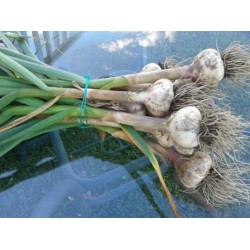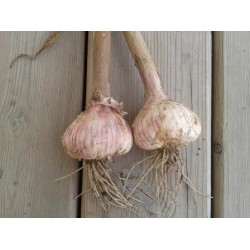
This year, I decided to change my garlic planting technique and incorporate—at least partially—the well-known Mittleider gardening method, which I first read about over 20 years ago. While I still avoid using any chemical fertilizers or pesticides, I truly appreciate the bed orientation, shape, and maintenance principles behind the method.
I planted my garlic in narrow rows with wide pathways between them, keeping both the beds and the walkways at the same ground level.
In previous years, I used to cover the beds with straw and hay. At first, it looked neat and seemed practical, but over time it caused several problems: weeds eventually took over, the soil compacted and hardened, and my poor garlic bulbs became crooked and stunted.
This year, I skipped the mulch entirely. I keep the soil loose and weed-free by light hoeing once a month, which also keeps the top layer nicely aerated. The pathways between the beds are simply scraped once a month to shave off young weeds before they establish.
The result? A garlic patch almost entirely free of weeds—a huge improvement compared to last year’s jungle. The plants are thriving in loose, well-aerated soil, and maintenance is much easier.
The only drawback came from an uneven planting site: after heavy rains, water pooled in the center, causing some bulbs to rot over the winter. A good reminder for next season—choose a level, well-drained location for planting.







10 Comment(s)
I will immediately grasp your rss as I can not to find your e-mail subscription link or newsletter service. Do you've any? Kindly let me understand so that I could subscribe. Thanks.
Hi! Someone in my Facebook group shared this website with us so I came to look it over. I'm definitely enjoying the information. I'm bookmarking and will be tweeting this to my followers! Fantastic blog and great design.
Hey! Do you know if they make any plugins to assist with Search Engine Optimization? I'm trying to get my blog to rank for some targeted keywords but I'm not seeing very good gains. If you know of any please share. Thanks!
I need to to thank you for this fantastic read!! I absolutely loved every bit of it. I have you book marked to check out new things you
Hey there! I've been reading your site for some time now and finally got the courage to go ahead and give you a shout out from Austin Texas! Just wanted to say keep up the great job!
I like what you guys are usually up too. This sort of clever work and exposure! Keep up the great works guys I've included you guys to our blogroll.
I wanted to thank you for this great read!! I certainly enjoyed every bit of it. I've got you bookmarked to check out new stuff you
Ahaa, its pleasant discussion concerning this piece of writing here at this webpage, I have read all that, so now me also commenting at this place.
I'll immediately grasp your rss as I can't find your e-mail subscription hyperlink or newsletter service. Do you've any? Kindly let me understand in order that I could subscribe. Thanks.
Wow, this post is pleasant, my younger sister is analyzing these things, therefore I am going to tell her.
Leave a Comment